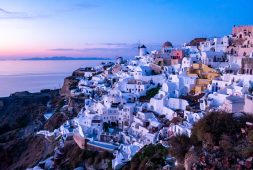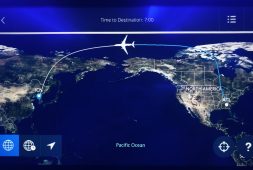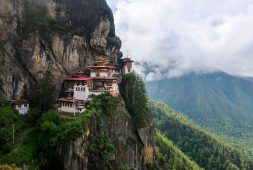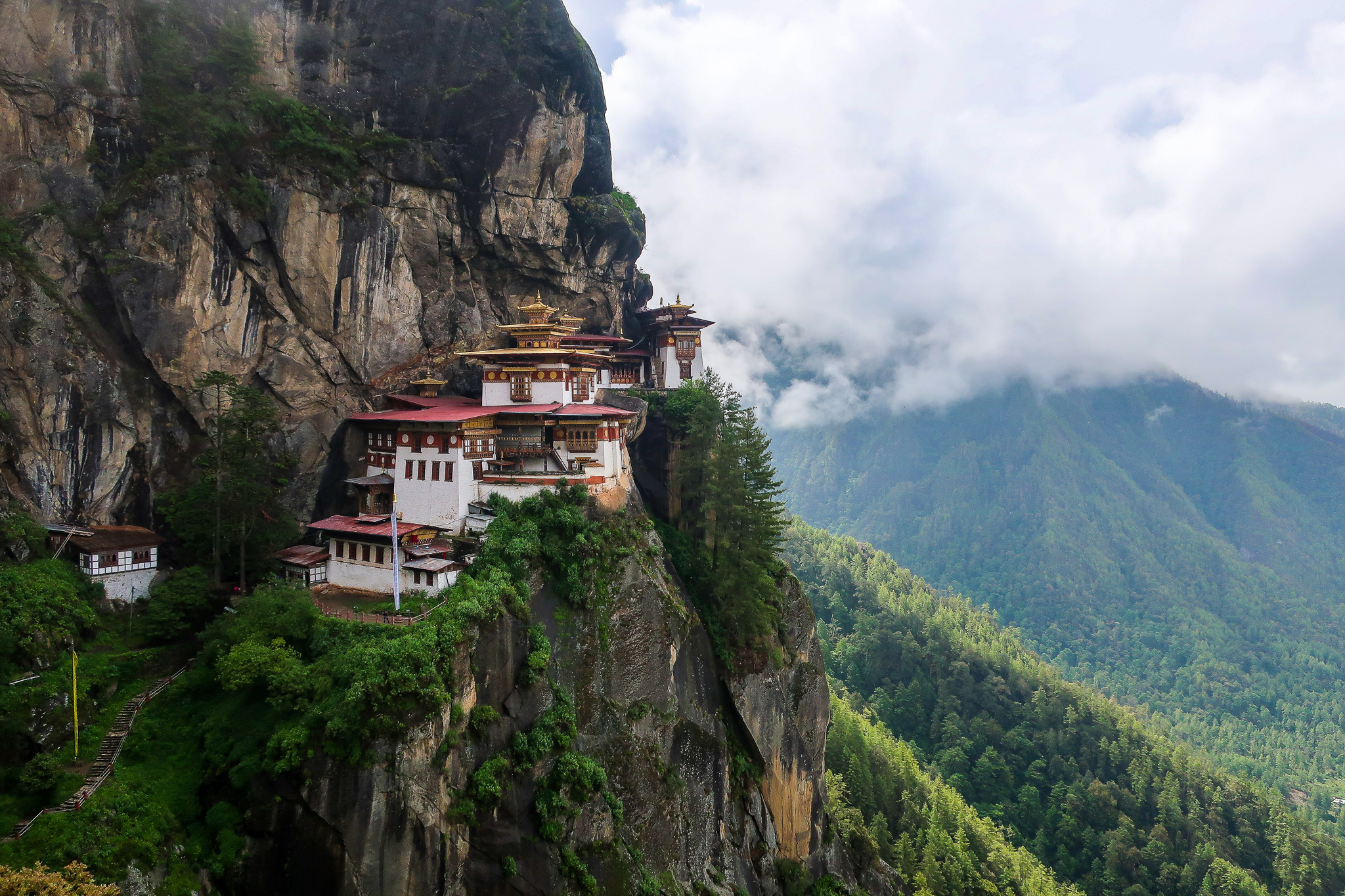
Thank goodness I had requested a window seat on my flight from Dhaka, Bangladesh, to Paro, Bhutan. As we prepared to land, I could see the side of the mountain outside of my window on the left side of the plane. And I looked to my right across the seats and out the window and could see a mountain on that side. Wow, we were flying in between two mountains to land in the valley of Paro. The plane made a hard right turn to follow the valley layout and then we swooped back to the left as the ground below drew closer triggering my body’s adrenaline. It was like a roller coaster ride.
The runway came into view and we softly landed in the valley. My guide would later tell me that only 11 pilots are trained to land into Paro. And if you google “world’s most dangerous airports”, Paro will certainly be in the top 10 if not close to the top due to the landing route weaving through the mountains. It was certainly exhilarating!
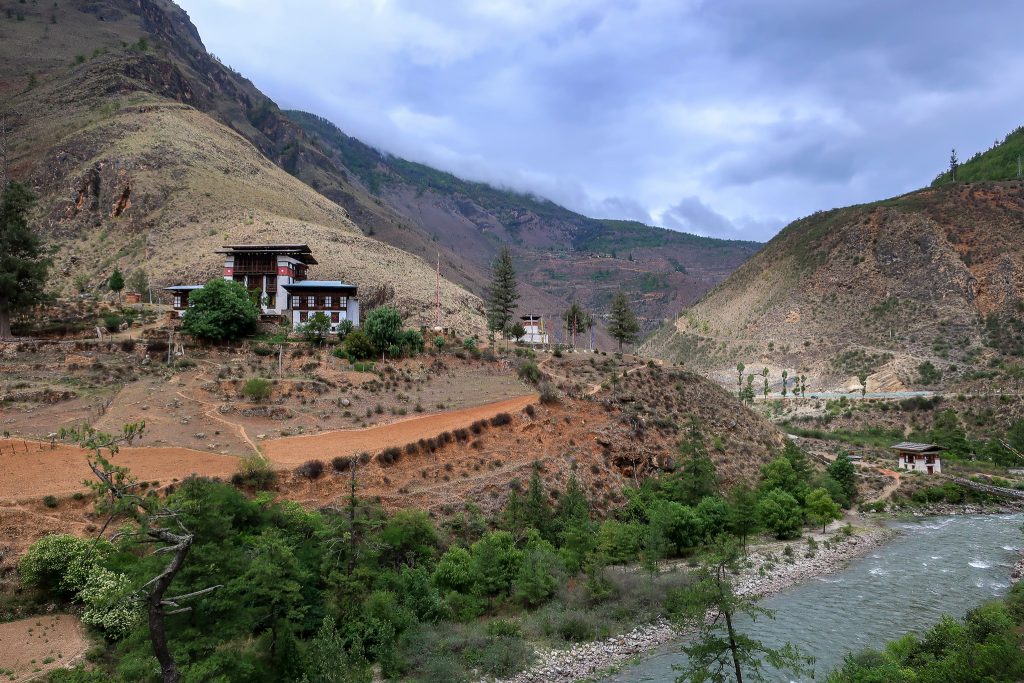
WHERE IS BHUTAN
Bhutan is a small landlocked country about the size of the state of New Jersey located in the Himalayan Mountains between China and India and just to the east of Nepal. The country has a total of 770,000 residents. Most of the residents live in larger villages with the largest village being Thimphu, which is the capital. The only international airport is located in Paro, about 50 kilometers to the west of Thimphu, because this is the only runway long enough for larger aircraft. The land is dominated by beautiful mountains and valleys. Over 60% of the land is inhabited.
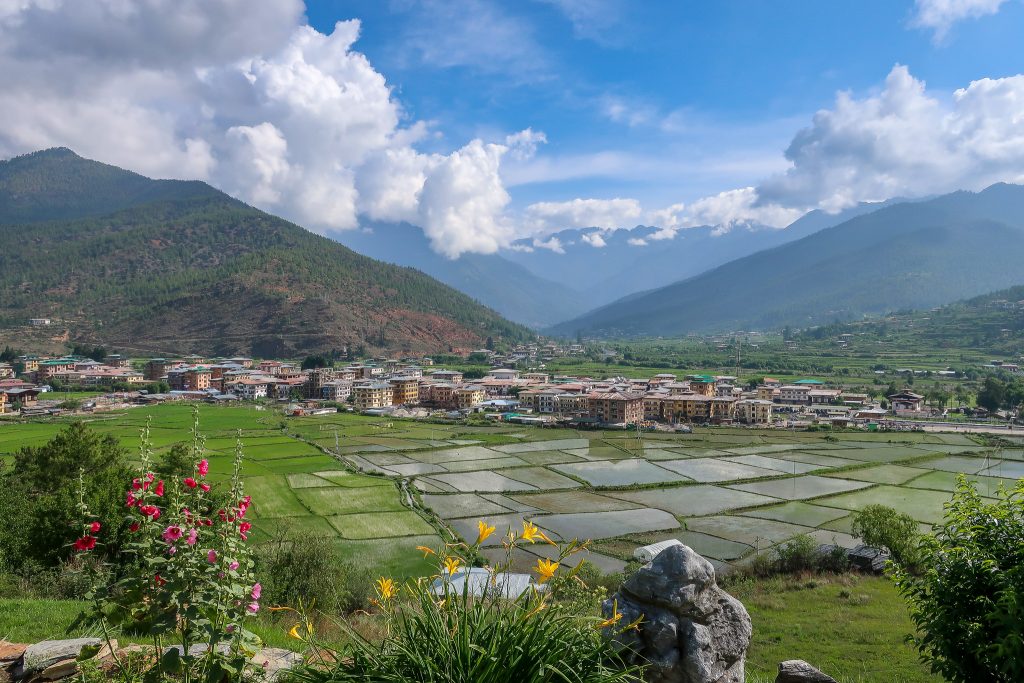
HAPPIEST COUNTRY ON EARTH
Welcome to Bhutan: the Happiest Country on Earth! The government actually produces the Gross National Happiness index each year as a testament to how happy the people are of Bhutan. The country is 100% Buddhist and they believe in treating each other with respect. I had asked if there is any crime in Bhutan and my guide told me no. Many have an argument here or there but can you imagine a country where most everyone is happy and treats each other kindly everyday?
So maybe you would want to move to Bhutan? Well, you can’t. No one born outside of Bhutan is allowed citizenship nor permanent residency. The country wants to protect their rich culture and ethnic background. The only exception to residing in Bhutan is if you marry someone Bhutanese. If a foreign woman marries a Bhutanese man, she can permanently live in Bhutan but will never become a citizen. If the couple has children, their children will become Bhutan citizens. However if a foreign man marries a Bhutanese woman, he can permanently reside in Bhutan but their children will not be granted Bhutanese citizenship.
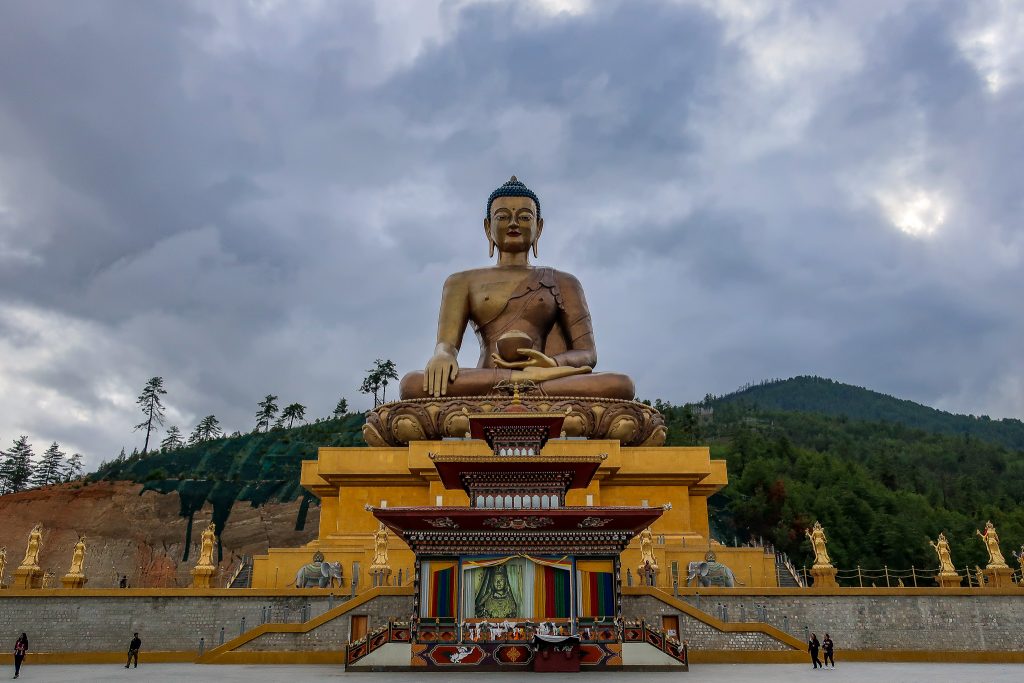
MINIMUM DAILY SPEND
Sounds restrictive, right? Well even as a tourist it is restrictive. You can’t just buy a flight into Bhutan and travel around freely. You must have a guide as a foreign tourist (unless you are from India, Bangladesh or the Maldives). And, the kicker is you must spend a minimum amount of money per day as a tourist. As a solo traveler in the low/rainy season (December to February, June to August), you must spend $200 USD per day plus a $40 USD per day tourist supplement. $240 USD per day total is the minimum amount that must be spent. If you travel with two or more, the daily tourist supplement drops to $30 per person. In the high/dry season (March to May, September to November), the minimum daily cost jump to $250 (plus the daily tourist supplement).
This sounds expensive (and it is for a backpacker), but the hefty fee does include pretty much everything excluding tips for the guide and driver. This daily fee covers the following:
- Full day guide
- Full day driver (yes, someone drives you wherever you want all the time)
- Hotel accommodations (includes 3 star hotels – you can pay more for a nicer hotel)
- Three meals
- All tourist entrance fees
- Bhutan visa
- Recommended itinerary from the tour company.
So while the minimum daily spend sounds crazy, it is actually really nice to have everything paid for and you don’t have to worry about a thing. The guide and driver pick you up from the airport and are with you for the entire visit (they do leave you alone at your hotel in the evenings).
There is a way to bypass all of the daily fees and that is to be invited into the country. But this is very rare and usually for business purposes. The local person or entity inviting you has to register you with the government and it is restricted for a certain amount of days.
Take a look at my video of my experience visiting Bhutan:
PROTECTING BHUTAN’S CULTURE
My guide, Gem, said that only 8,000-9,000 tourists visit Bhutan each year. That is much less than the number of visitors to Antarctica each year which is estimated to me 20,000-25,000. The government certainly restricts tourists as they are trying to protect the culture as much as they can. After traveling through all of Southeast Asia, I can certainly see how tourism can impact a country. While tourism produces much income, the land, people and culture are all impacted. If you open up your borders to anyone, then it opens up the possibility for those people to visit and impact the environment and culture. Bali, Indonesia, is a good example of letting many tourists come into a beautiful, culturally rich country and trashing the area. Many tourists use Bali as their vacation playground, not respecting the land and culture, and then leaving. This same thing has happened recently at Boracay Beach in the Philippines and the government shut the city down for six months this year (2018) to clean up the mess left by tourists.
Bhutan wants to share their scenery, culture and people, however they basically impose a visitor tax to prevent just anyone from entering. It is a high threshold to visit. The country wants to limit any outside influences.
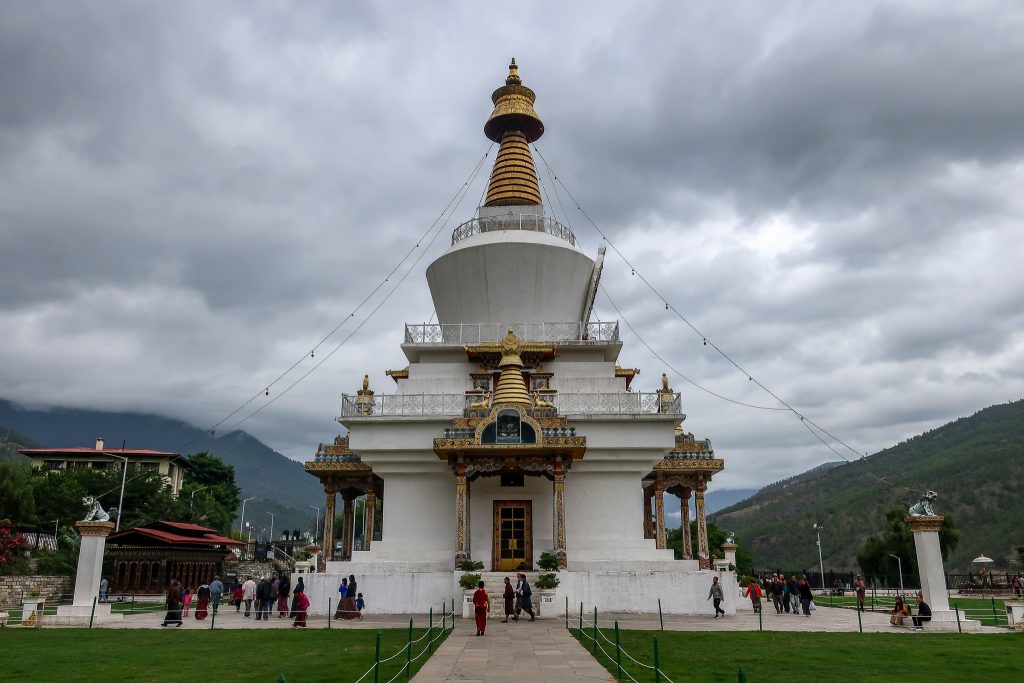
ALL ANIMALS RUN STRAY
The Bhutanese culture is very rich. As they are a Buddhist country, they let all animals roam freely, including cows and dogs. As you drive along the roads of Bhutan, you will often have to stop for cows in the road. And the government protects all stray dogs by feeding them in the winter months. And because of the Buddhist culture, over 80% of the population are vegetarian (20% slightly relax the Buddhist beliefs).
The government also has some strict penalties for substances such as tobacco. Tobacco is 100% banned. Tourists are allowed to bring tobacco into the country but it is 100% taxed upon entry. And if anyone is caught smoking outside of the few designated smoking areas, you are subject to a hefty fine and automatic three year jail sentence.
FREE HEALTHCARE, EDUCATION AND LODGING
And it’s no wonder why the residents of Bhutan consistently rank their happiness very highly. Each resident receives free education, including secondary education. If a student wants to study abroad anywhere in the world, the government will pay all expenses (travel, lodging, tuition, other costs) to study. In addition to free healthcare for all residents, the government also provides a home to all first time home owners free of charge (most likely a condo in a multi-family building). If you decide to build a residence or commercial building, the government does have strict rules on the traditional architecture with the square, pagoda-like roofs, which came from Tibet.
Bhutan’s main source of income is hydroelectric power from the mountain water sources, exporting power to India and Bangladesh. Tourism and agriculture (primarily red rice) are the second and third main exports, respectively. All workers must abide by the country’s dress code, which is long dress-like bottoms for men and a long dress for women. It is very unique.
The country of Bhutan is stunningly beautiful. There were moments that I felt like I was in a small mountain town in the U.S. state of Colorado, and then moments where I knew I was in the Himalayas. The elevation of Paro and Thimphu is around 2,300 meters above sea level (nearly 7,000 feet). I believe the continental divide in Colorado is close to this altitude.
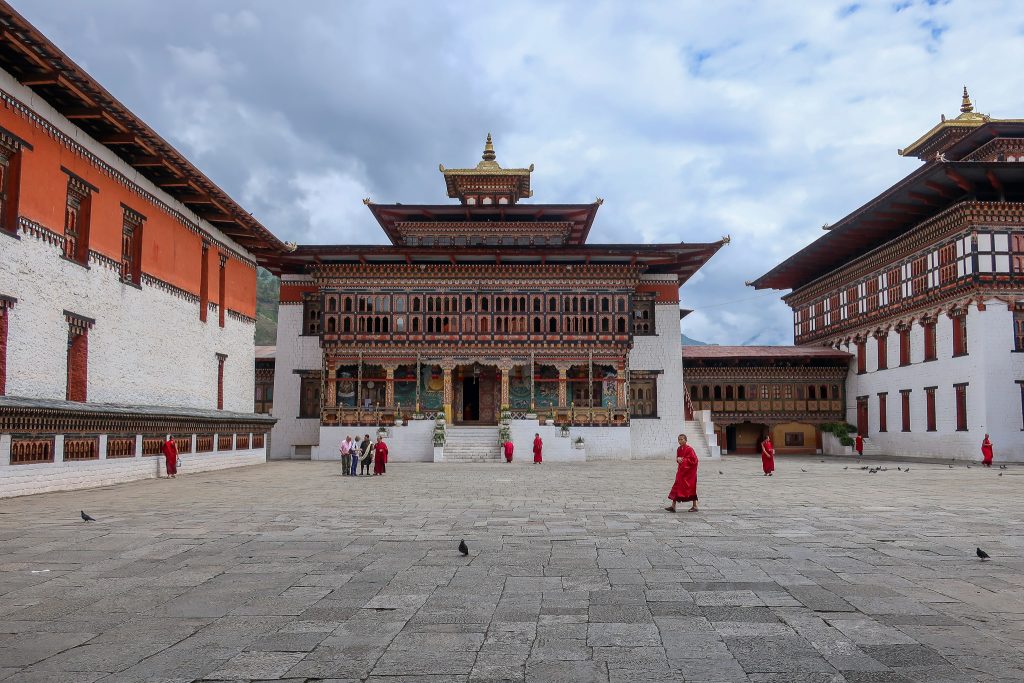
VISITING BHUTAN
I stayed in Bhutan for a total of three nights / four days. And I would say this is the perfect amount of time for a visit unless you want to do something specific outside of the main tourist attractions in Paro and Thimphu. The typical three night itinerary will be the first night in Thimphu and then two nights in Paro.
These two places will allow you to see the beautiful dzongs (monasteries), Buddhist temples and of course the country’s crown jewel, Tiger’s Nest!
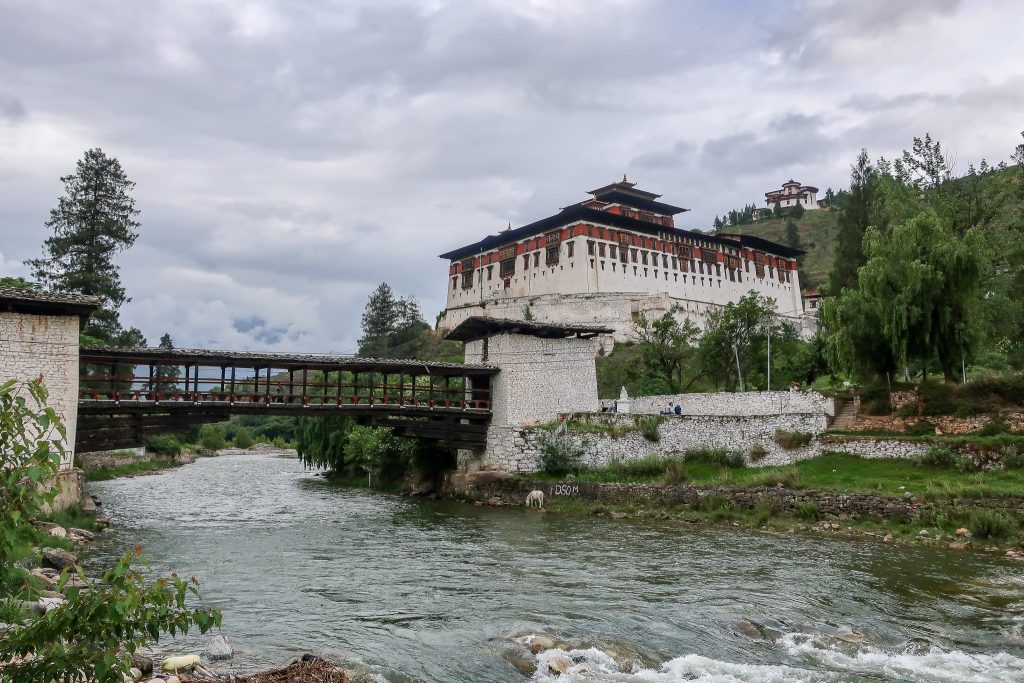
TIGER’S NEST
The Tiger’s Nest is a Buddhist monastery built in the 8th century along a mountain face about a 30 minute drive to the east of Paro. And it is said to be one of the most sacred Buddhist Temples in the world as the second Buddha traveled here to meditate in one of the caves. My guide showed me the door of the cave that is only opened once per year. I have been interested in learning more about Buddhism so my guide began teaching me basic principles along my journey and we were able to meditate in the temple in Tiger’s Nest, one of my trip’s most incredible moments!
Getting to the Tiger’s Nest is not for just anyone. There is no road that goes directly up to the monastery that looks as if it is just hanging delicately on the side of a flat rock face. The only way up is a very treacherous hike. You begin hiking at 2,300 meters and climb 800 meters along a very muddy and steep at times path to 3,100 meters. It takes the average person (not fit) to reach the monastery in two hours.
THE TREK ISN’T FOR EVERYONE
You must be in good shape to make this climb at this high of an altitude. My guide told me that last October one of his tourists from Germany who was 65 years old had a heart attack half way up the mountain and there was nothing anyone could do. He died on the mountain. He had mentioned that he had open heart surgery a year earlier and his doctor told him not to climb within one year. My guide even told the guy not to do it. But he insisted and paid the ultimate price.
Since the climate is very damp during the low season, the dirt paths of the trek up to the Tiger’s Nest turn to mud. It made the trek much more challenging because it was slippery on the steep climb. I had to find tree roots and small rocks to push off of as I stepped up. Many tourists couldn’t make it the entire way. Some people slipped and fell and were covered in mud. And then I saw one woman [nationality unnamed] in flip-flops with her guide basically carrying her [Shaking my head]!
Common sense tip: don’t wear flip flops for an 800 meter climb on muddy paths.
My guide wasn’t in the best of shape. As we started hiking, I turned the trek into a leg workout. There were points along the way where I became light-headed so I paused to drink some water and catch my breath. But I pushed on, left my guide behind and eventually passed all the tourists. I pushed on to the top.
PRAYER FLAGS AND PRAYER WHEELS
As the sun poked through the low clouds, the trail lit up and I felt so much peace. I could see many prayer flags hung among the trees. My guide told me that the multi-colored flags (one color for each earth element for a total of five and with Buddhist prayers printed on them) were strung up in the mountains so the wind could carry the prayers as far as it blew and they were strung along rivers so the water could carry the prayers down stream.

About half way up, I passed a large prayer wheel. It was a large hollow drum painted in beautiful colors with a handle along the entire base. My guide told me that Buddhism has so many teachings that it is nearly impossible for our human brains in to retain all of them. So the prayer wheel contains a script on the inside which is a summary of all the Buddhist teachings. And the idea is that as you manually spin the prayer wheel clockwise, you can pray on all the teachings and release any sins. So as I passed the giant wheel, I reflected on much that has happened in my life over the past year and took deep breaths. I felt a deep sense of calm come over me.
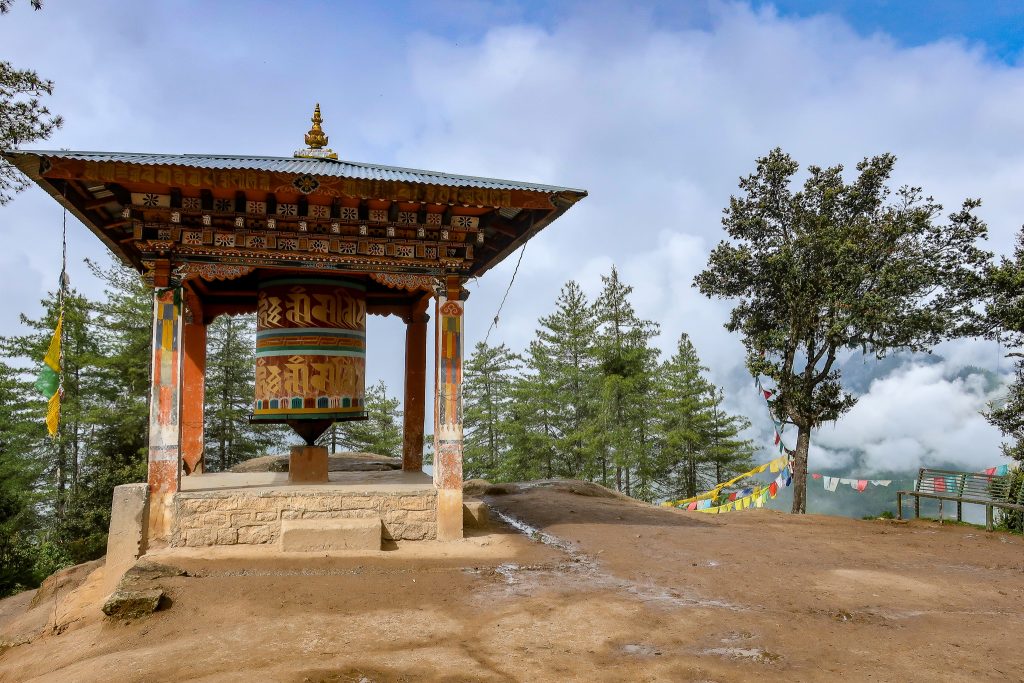
GOOSEBUMPS WHEN YOU FIRST SEE TIGER’S NEST
I continued up the mountain with a huge smile on my face loving everything about this adventure. And then I turned a rocky curve and there it was. The Tiger’s Nest directly in front of me across a huge chasm.
I got goosebumps and found a place to rest as I stared at one of the most beautiful things that I have ever seen. Since I had passed everyone an hour ago, I had plenty of time to sit alone, breath and reflect on this moment and on my journey! I still can’t believe this journey has brought me to this place. It was one of those life moments where you feel like you are in a movie. The camera is focused on you and then slowly pans out to capture the full, breathtaking scene with inspiring music slowly getting louder. And everyone watching the movie has goosebumps causing them to get emotional as they can relate to their own lives.
After spending time in silence with the 8th century monastery perched on the cliff directly in front of me, I began to climb down many, many steps to traverse around the side of the chasm that separated me and the structure. I was rewarded with a huge waterfall next to the walkway and then the final set of stairs led to the monastery. I had made it in two hours (with about a 20 minute meditative moment).
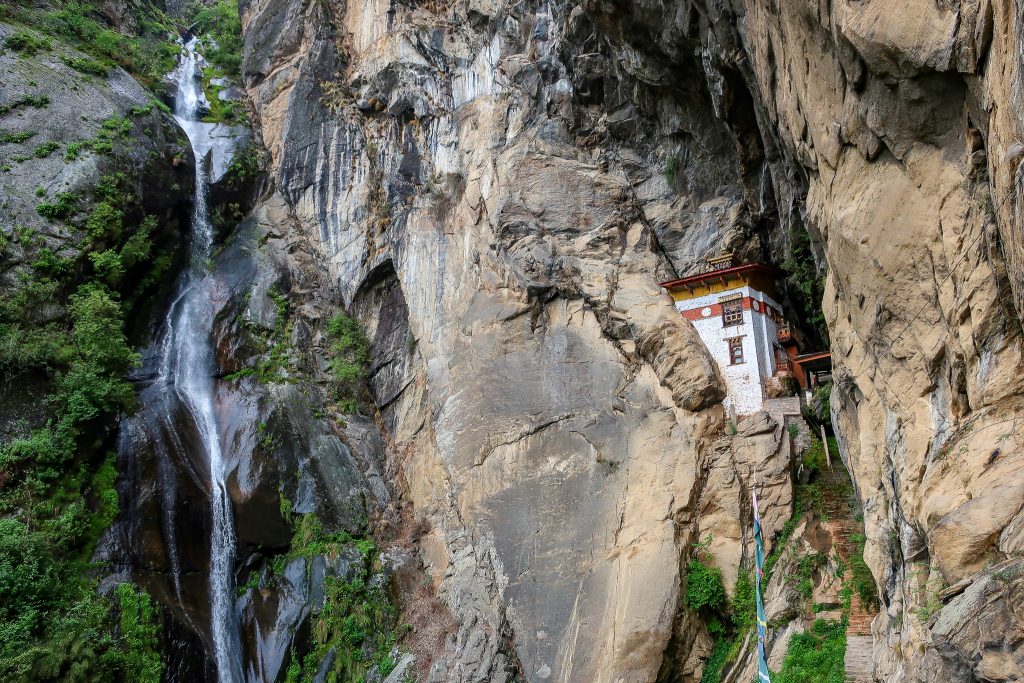
By this time, my guide had caught up to me along with some other quicker trekking tourists. Perfect timing since I needed my guide to get inside the monastery. He showed me the door to the sacred cave and around the inside the monastery’s main temples. I wasn’t able to take any photos inside but it was one of the most beautiful rooms that I had ever seen. Many, many bright colors filled the walls and ceilings. The main feature was the front of the temple where a gold replica of Buddha sat. It was a remarkable moment to be standing in this room knowing that many other important Buddhists stood in the same spot.
ONE OF LIFE’S MOST BEAUTIFUL MOMENTS
My guide and I sat in silence for a while. He wanted me to shut my eyes and focus on the second Buddha’s birth from a lotus flower in a lake in India. And then focus on the light entering my third eye. We sat in the silence, in this small temple, perched on the side of a mountain at 3,100 meters, with our minds fully immersed with the imagery. Another important moment of being the most present that I have ever been.
My mind was not thinking about the past. My mind was not thinking about the future. My mind was focusing on the now, the present, the most important moment. I became overwhelmed with so many feelings knowing where I was. My eyes filled with water and my body overcame with emotion from this most beautiful moment. I set out on this journey many months ago to heal and to find myself. Many moments leading up to this moment have prepared me to feel this. And this moment helped me heal. Happiness has found its way out from behind the dark cloaks that have been wrapped around it inside of me.
After we meditated, we walked up to the “altar” area and poured holy water into our hands. We drank some and poured the rest on our heads. I pulled my hands together, placed them on my third eye, bowed and thanked the universe for one of the most special moments that I have ever had.
Take a look at the video of my unforgettable experience climbing Tiger’s Next
Have you ever visited Bhutan? Tell me about your visit below.
